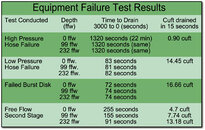Funny you should post this, I was just thinking about it recently, in the context of how much time do you have at depth before the air supply is exhausted by various types of leaks. I am going to give a subjective 'guesstimate' response, and welcome correction from others with more objective data.
- LP hose-first stage connection: Air goes out of the tank quite fast and, after getting your buddy's reg you must close the tank valve to be able to see properly and calm down. If the air is coming out of the low pressure port, it should be coming out at intermediate pressure, i.e. ~140-145 PSI. That is still much higher than the ambient pressure of the surrounding water whether you are at 30 feet (~29 PSI) or 130 feet (~73 PSI). What I don't know is the maximum delivery rate through the port aperture. But, even with a full-blown failure, at the hose connection, you could still breath off the reg and make an ascent to the surface.
- HP hose-first stage connection: Same but... less air goes out? (high pressure, smaller aperture? I'm guessing here) The first stage HP port aperture is actually similar to, but a little larger than, the LP port (7/16" diameter for the HP, vs 3/8" for the LP). What is smaller is the aperture of the male HP hose connection. If you look at the male / first stage end of a HP hose, you will see a very small hole, that is the conduit for HP air to the SPG. If the failure is at the connection, you should have high pressure (tank pressure) air coming out of the port. I would presume the air loss would be greater with this failure than with a LP hose - first stage connection failure
- First stage-tank connection: No idea. Can this even reasonably happen? Any difference between having a yoke or din open tank on your back? Sure it can happen, if the O-ring fails / extrudes, or a yoke reg is 'bumped' out of position u/w. A primary advantage of a DIN connection over a yoke connection is that O-ring failure is very unlikely with DIN - much more likely with yoke. I have no idea how many times in 'real life' a catastrophic failure of the yoke O-ring actually occurs, although I have seen one u/w, and it is spectacular, but not life-threatening. You would still have time to surface from most recreational dives, unless you were already at 500 psi when it occurred - even then, an immediate ascent would be doable. Think about how long it takes to drain a tank on the surface, when you open the valve handle all the way. It doesn't happen in seconds, rather it takes minutes.
- Second stage-hose: Would it be possible to stop the airflow without closing the tank valve in this case? If the falure is at the point of connection between the hose and the second stage, I presume it would be possible to fold the hose over enough to crimp it and reduce the air flow, and you would then switch to your alternate reg (presuming it was your primary hose that failed. Either way, the maximum air loss would be similar to what would occur if the failure occurred at the hose connection with the first stage - intermediate pressure air escaping.
- SPG-hose: Would it be possible to stop the airflow without closing the tank valve in this case? Probably not.





